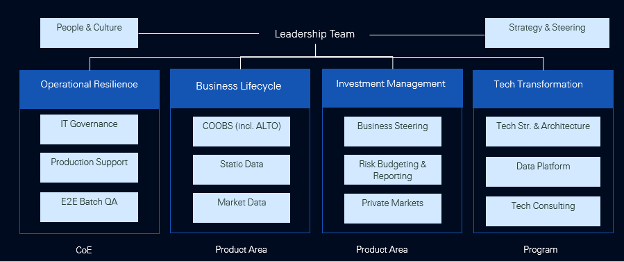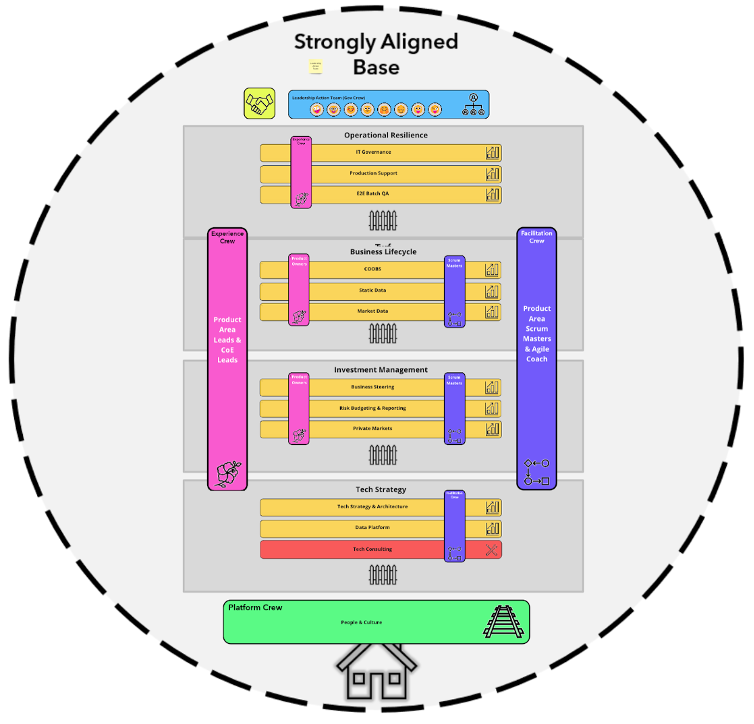unFIXing a Swiss insurance company
Author: Jan-Paul Ouwerkerk
Sometimes agile transformations need a little luck to get their first spark. In 2008 Matthias Gebhardt was offered an extensive 8-day systemic organization training by his manager. It was about people coaching, theory U, systems thinking, and more. It gave him a deep understanding of how (organizational) systems work, and it sparked the journey that we will try to grasp in this case study, the agile transformation within Swiss Re Asset Management IT (AMIT). And, of course, we will tell you how they ended up using unFIX.
“Sometimes agile transformations need a little luck to get their first spark.”
The Swiss Re Group is one of the world's leading providers of reinsurance, insurance, and other forms of insurance-based risk transfer, working to make the world more resilient. The aim of the Swiss Re Group is to enable society to thrive and progress, creating new opportunities and solutions for its clients. (www.swissre.com)
This multi-billion dollar Fortune 500 company has a presence globally and operates in most markets. With over 14,000 employees, it is serious business.
From auto-pilot to personal resilience
Before his training, while successful, and like so many others, Matthias was going through life on auto-pilot, it was business as usual for him. After the training that changed quite dramatically, he experienced something new, an ability that would unlock his own full potential and drive personal growth, and because of that, he saw the (working) world quite differently. He wondered how it would be possible to do the same within AM IT and how an entire organization could explore and benefit from this concept.
With his leadership team, they imagined creating an organizational system that provides balance, that institutionalizes slowing down to speed up (McKinsey & Company), that drives change at the same time offers resilience, and that is highly efficient at the same time takes super care of employees.
Understanding that their department was constantly facing added complexity and change, they knew that similarly, their employees would need to balance their own systems and be given the opportunity to also slow down and reflect.
Together they decided to put this into practice by introducing systemic coaching. It started with all the leadership team from their 100+ people department going through the same training and coaching. The lessons learned and the action taken led to much more personal talk and, ultimately, more trust in each other. When you start talking about private lives, marriage, friends, and even about death, trust within the team accelerates. Coaching each other really made an impact. It led to uncovering latent talent and realizing one’s hidden potential through a continuous process of building self-assurance and belief in oneself.
“When you start talking about private lives, marriage, friends, and even about death, trust within the team accelerated.”
After this more gradual and informal path of growth around 2017, coaching became more official. The structure was evolving (see fig. 1.0 below), first by offering, systemic coaching to all their employees. People could choose their own coach (with some boundaries, for example, a coach should work at the same office, but not in the same team).
This helped employees to pause, spend some time with their inner selves, discover horizons never thought of before and explore a world of possibilities.
Figure 1.0 (after “normal” structural change)
Reasons for change
The main reasons for change were the same challenges many organizations struggle with. They need to deal more and more with digitalization, technology, and complexity in order to become a leading data driven engineering company. After insourcing some software teams in the early years, some dependency problems arose. Teams were waiting for each other, working in silos, and in general not collaborating well. And because of that, there was much waste in the system and as a result people became unhappy.
This was also when the first part-time agile coaches started working within the department. Initially, those agile coaches looked at the possibilities of using parts of the so-called “Spotify model”. AM IT leadership liked parts of it but not everything. For example, after a period of experimenting with the role of the manager (Chapter lead), they chose not to use the role at all. They found stability in developing an organization where product owners take care of customer delivery and products whilst systemic coaches take care of people.
In 2019 Duncan Fletcher was hired to help with the journey within AMIT as the first full-time Agile Coach. He quickly teamed up with Matthias joining the leadership team to discuss evolutions of their department's organization and agile practices to lead them into the future. With everyone having a systemic coach independent of their role or team, they were able to explore re-teaming and adapting existing teams to their own department’s needs and their client's needs (value crews, facilitation crews, governance crews) with little to no impact on reporting lines and HR processes.
In 2021 their mother company, the SwissRe Group, also embarked on an InfoTech-wide agile transformation journey, and they looked at AMIT to lead it with their own lighthouse example. But we will stick with the transformation within AMIT for now.
We were doing unFIX
That was when Matthias, always looking for the next step, asked Duncan what comes after the “Spotify Model” and “Agile”? Duncan took that challenge not light-hearted; he talked to experts and researched online how to best continuously evolve an organization. And at some point spoke to a member of the unFIX community in Zurich who introduced him to unFIX. After reading up on the website, it struck him that what they were doing within AMIT was strikingly similar to the patterns unFIX describes. He immediately introduced it to Matthias and the leadership team and started to play around with the patterns himself.
“What comes after the “Spotify Model” and “Agile?”
He first tried mimicking the 1.0 org chart with the result shown in the org 2.0 picture below.
Figure 2.0 (unFIX mimic of 1.0 org chart)
There was one Strongly Aligned Base with four turfs for each focus area. Within the turfs were multiple Value Stream Crews, each supported by a Product owner and a Scrum master. The POs acted as a link to the customers and joined an Experience Crew to align. The Scrum Masters joined forces in a Facilitation Crew to be aligned about ways of working and (base-wide) impediments. The different leaders managing the brother stakeholders form a Governance Crew. A Platform Crew of systemic coaches within “People & Culture” take care of the people inside the Base.
After joining a workshop with one unFIX partner, The Ministry Group, they introduced the unFIX thinking and patterns to the rest of the leadership team. They liked it immediately.
The whole group has a lot of ongoing conversations about the future, knowing that the organization needs to be flexible for future challenges. Based on the discussion they create the next organizational org chart by adding more unFIX patterns (see figure 3.0). Still early in their “unFIX journey”, we agreed that we could do another interview and publication in about six months!
Figure 3.0 (unFIX possible future)
We are really curious about what the future will bring and what benefits they will take from this new flexible way of working. And, of course, we would like to thank Matthias and Duncan for this opportunity to interview them and share their story with our community. Ensure you contact them or us directly to ask them any follow-up questions! Stay tuned!
===
Many thanks to Duncan Fletcher and Matthias Gebhardt for the time they made available for this case study.




